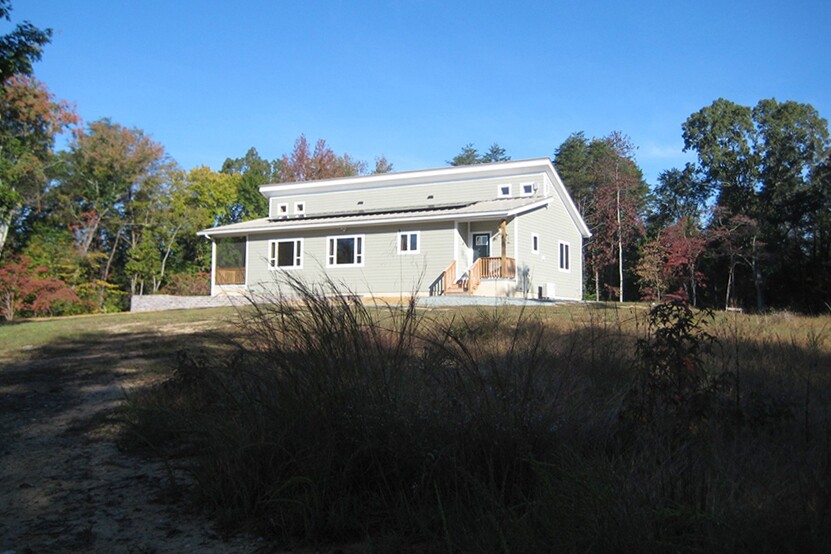
When Shaun Alfreds and his wife decided to build a house for their family of five in Cumberland, Maine, they didn’t know if a high-performance project would be within their budget. “We aren’t wealthy by any stretch of the imagination, but we wanted an energy-efficient home,” says Alfreds, a chief operating officer at HealthInfoNet, a local health information technology company.
After some research, however, the couple realized that they achieve their dream for a nominal additional investment over the cost of a conventional house if they opted for a modular high-performance house. They chose a two-story, Cape Cod–style design from Portland, Maine–based BrightBuilt Home, and moved in last December.
At more than 3,000 square feet, the house is spacious, but its full sun exposure and a 10-kilowatt solar array of 39 photovoltaic (PV) panels should cover its energy consumption year-round. Alfreds says the house cost “almost exactly what other [builders] were bidding” for a standard, code-compliant project that was custom designed. And their small additional investment goes to building equity in the house, rather than to paying utilities.
BrightBuilt, a sister company of local firm Kaplan Thomson Architects (KTA), joins an increasing number of design companies that are expanding the market for high-performance residential projects. While KTA has custom-designed many energy-efficient houses, principal Phil Kaplan, AIA, says the firm also wanted to offer an off-the-shelf product. In 2015, it launched BrightBuilt with nine design templates. Starting at $175 to $180 per square foot, the houses bring net-zero energy to a price more people can afford. “We’re definitely seeing a lot of demand,” Kaplan says.
But some architects and builders have found ways to lower the price of net-zero housing even more.

Marie de Verneil dreamed of building a retirement home on land she owned in central Virginia. “To me, green was very important,” she says. However, her savings from teaching French and international relations at the University of Maryland, Baltimore County, didn’t seem like enough. “It’s kind of discouraging for someone like me,” she says.

Then de Verneil heard about Deltec Homes, in Asheville, N.C. The company—known for its distinctly round, prefabricated, and hurricane-resistant houses—recently launched Renew, a collection of models that use about two-thirds the energy of a conventional house and can include a PV array. De Verneil estimates she spent $250,000 on her 1,600-square-foot house (less than $160 per square foot), which includes a roof-mounted solar array. Her monthly electric bill is $30, the base fee for taxes and distribution. And when she is retired and living on a fixed income, she knows she’ll never have to say, “I can’t put the heat on.”
For those wanting to build a passive or net-zero energy house, right-sizing expectations is a crucial step to meeting one’s budget. And, as Deltec president Steve Linton adds, every project—modular or not—must be tailored to the particular site and climate. The company’s design team also conducts an energy model to evaluate site variables, solar energy capacity, building-shell size, features, and cost trade-offs.
Much of the market for high-performance housing is around single-family units in the suburbs, but the past few years have seen an uptick for multifamily dwellings and affordable housing projects in cities, including Washington, D.C., New York, and Philadelphia.
For low- and middle-income residents, in particular, an energy-efficient house can provide substantial benefits, says Orlando Velez, director of Housing Programs and Community at Habitat for Humanity of Washington, D.C.The organization recently built six passive townhouses last year in the district’s Ivy City neighborhood, whichhas a lot of air pollution. By creating a tight building envelope and filtering outside air, “you’re improving the air quality significantly,” Velez says. “It’s a healthier living environment.”
With savings from the lower utility bills, he says, residents may be able to spend more within the community. The organization plans to study those benefits over time to know whether energy efficiency is the best investment for its limited funds.


Living in a high-performance house can take some adjustment. Residents are often unfamiliar with high-tech HVAC equipment, such as energy recovery ventilators and solar water heaters. A tight building envelope also means that the size of the HVAC system can be decreased (fresh air supply is increased for indoor air quality purposes). The word that many residents use is “comfort”—indoor temperatures stay remarkably consistent across different areas of a house throughout the year.
read more…
http://www.architectmagazine.com/technology/living-the-dream-of-a-net-zero-house_o
